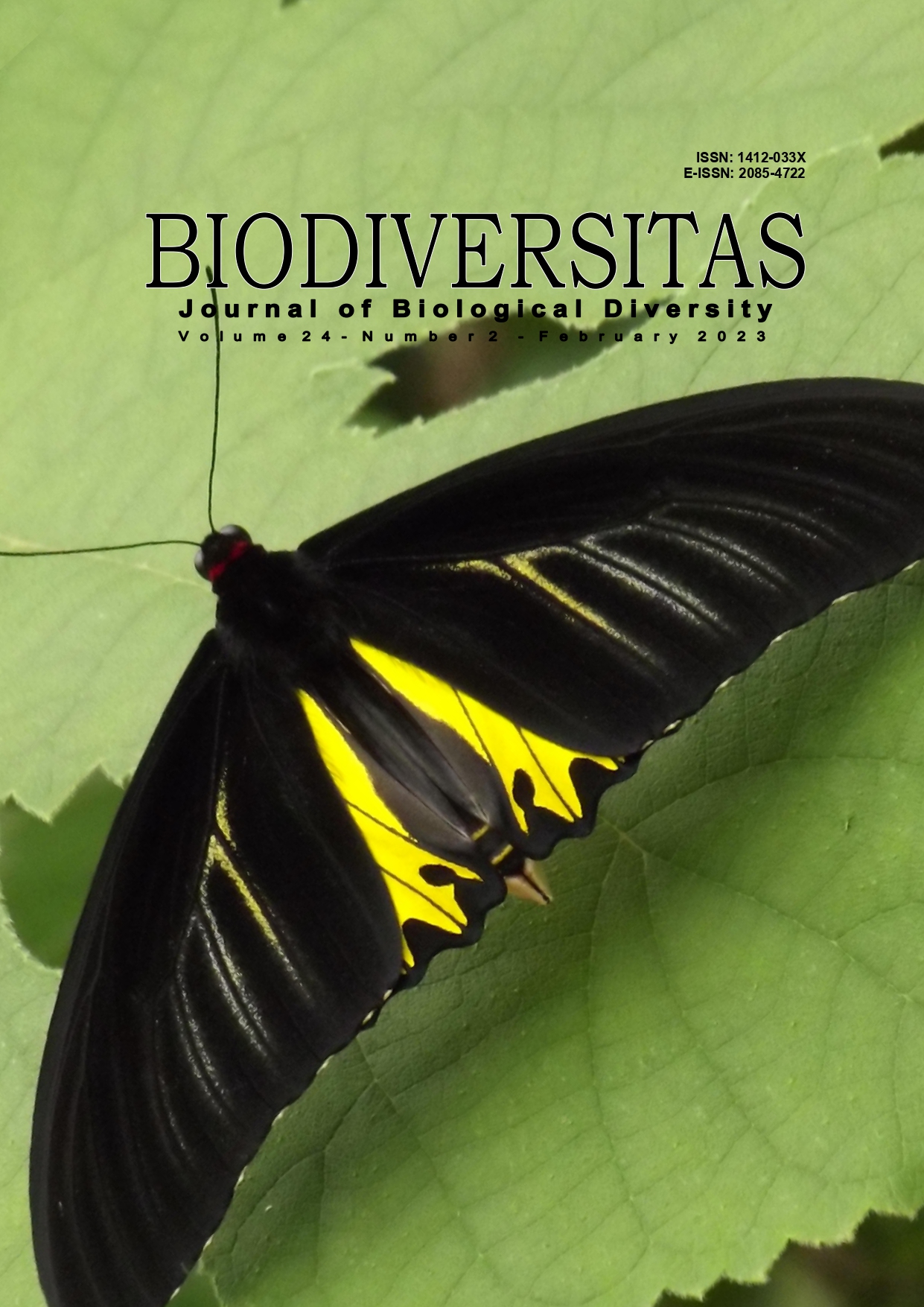Phylogeny and taxonomic status evaluation of Dark-sided Narrow-mouthed Frog, Microhyla heymonsi, (Anura: Microhylidae) from Sumatra, Indonesia
##plugins.themes.bootstrap3.article.main##
Abstract
Abstract. Eprilurahman R, Atmaja VY, Munir M, Ubaidillah R, Arisuryanti T, Smith EN, Hamidy A. 2023. Phylogeny and taxonomic status evaluation of Dark-sided Narrow-mouthed Frog, Microhyla heymonsi, (Anura: Microhylidae) from Sumatra, Indonesia. Biodiversitas 24: 1092-1103. Microhyla heymonsi (Dark-sided narrow-mouthed frog) was once known to be widespread along the continent of Asia from Taiwan to the mainland of east and southeast to Nicobar Islands and Sumatra. Recent studies identified that this species is cryptic species consisting of M. heymonsi itself and several newly described species, i.e., M. daklakensis, M. heymonsi, M. nakkavaram, M. ninhthuanensis, and the possibility of unnamed lineage. In Sumatra, M. heymonsi is not only distributed from the north to south of the mainland but also in the adjacent islands in Nias. Regarding the taxonomic status of Sumatran population, here we used molecular and morphological data to evaluate the taxonomic status of the Sumatran M. heymonsi. The phylogenetic analyses show that the Sumatran M. heymonsi is closest to M. nakkavaram and strongly supported as a member of subgroup M. heymonsi along with other recognized species, i.e., M. daklakensis, M. heymonsi, M. nakkavaram, and M. ninhthuanensis. The morphological assessment of Sumatran M. heymonsi shows that they are suitable with the morphological characteristic of M. nakkavaram. Both molecular and morphological data strongly support that Sumatran M. heymonsi is identical to the M. nakkavaram from Nicobar Islands. Our results expanded the distribution of M. nakkavaram, not only in Nicobar Islands but also in Sumatra and its adjacent islands. In addition, the phylogenetic tree showed the supported clade of Nicobar and Sumatran M. nakkavaram as sister taxa of the possibly undescribed species from Singapore and Peninsular Malaysia. Further study of this undescribed species is urgent.
##plugins.themes.bootstrap3.article.details##
Most read articles by the same author(s)
- FITRA ARYA DWI NUGRAHA, FATCHIYAH FATCHIYAH, NIA KURNIAWAN, ERIC NELSON SMITH, Phylogenetic analysis of colubrid snakes based on 12S rDNA reveals distinct lineages of Dendrelaphis pictus (Gmelin, 1789) populations in Sumatra and Java , Biodiversitas Journal of Biological Diversity: Vol. 19 No. 1 (2018)
- DWI SENDI PRIYONO, AKBAR REZA, RURY EPRILURAHMAN, DONAN SATRIA YUDHA, FARADINA MUFTI, NOORMAN HENDRY FAUZY, RADEN BAMBANG TRIYONO, PANGGIH KURNIA ADHI, Aquatic biodiversity in a pond on the airport landside areas through environmental DNA metabarcoding: Implementation for Aviation Security Management , Biodiversitas Journal of Biological Diversity: Vol. 23 No. 7 (2022)
- SRI WAHYUNI, I WAYAN SUPARTHA, ROSICHON UBAIDILLAH, I NYOMAN WIJAYA, Parasitoid community structure of leaf miner Liriomyza spp. (Diptera: Agromyzidae) and the rate of parasitization on vegetable crops in Lesser Sunda Islands, Indonesia , Biodiversitas Journal of Biological Diversity: Vol. 18 No. 2 (2017)
- MUHAMMAD ALIF FAUZI, AMIR HAMIDY, NIA KURNIAWAN, Harvesting trends of Amboina box turtles (Cuora amboinensis) seventeen years after listing in Appendix II CITES , Biodiversitas Journal of Biological Diversity: Vol. 21 No. 3 (2020)
- LINDUNG TRI PUSPASARI, DAMAYANTI BUCHORI, ROSICHON UBAIDILLAH, HERMANU TRIWIDODO, PURNAMA HIDAYAT, Diversity of insect galls associated with Eucalyptus alba & E. urophylla in altitudinal zones in Timor Island, Indonesia , Biodiversitas Journal of Biological Diversity: Vol. 22 No. 7 (2021)
- ABINAWANTO ABINAWANTO, HANI HAMIDAH, ANOM BOWOLAKSONO, RURY EPRILURAHMAN, Short Communication: Biometric of freshwater crayfish (Cherax spp.) from Papua and West Papua, Indonesia , Biodiversitas Journal of Biological Diversity: Vol. 19 No. 2 (2018)
- Husni Mubarok, Niken Satuti Nur Handayani, Ibnu Maryanto, Tuty Arisuryanti, Karyotype variation in lesser short-nosed fruit bat Cynopterus brachyotis (Müller 1838) from Special Region Yogyakarta, Indonesia , Biodiversitas Journal of Biological Diversity: Vol. 22 No. 5 (2021)
- TAUFAN NURZAMAN SULAEMAN, AMIR HAMIDY, ACHMAD FARAJALLAH, ANTOINE FOUQUET, AWAL RIYANTO, EVY ARIDA, MULYADI, WAHYU TRILAKSONO, MISBAHUL MUNIR, Mitochondrial DNA suggests the existence of two distinct species in Moluccas and New Guinea within Nyctimystes infrafrenatus (Günther, 1867) , Biodiversitas Journal of Biological Diversity: Vol. 22 No. 8 (2021)
- ERNIWATI ERNIWATI, ROSICHON UBAIDILLAH, Hymenopteran parasitoids associated with the banana-skipper Erionota thrax L. (Insecta: Lepidoptera, Hesperiidae) in Java, Indonesia , Biodiversitas Journal of Biological Diversity: Vol. 12 No. 2 (2011)
- FAIZAH NUR SHABRINA, KUNTO WIBOWO, TUTY ARISURYANTI, Cryptic diversity of mudskipper genus Boleophthalmus (Gobiiformes: Oxudercidae) from the north coast of East Java, Indonesia , Biodiversitas Journal of Biological Diversity: Vol. 25 No. 1 (2024)


 https://orcid.org/0000-0003-2748-3017
https://orcid.org/0000-0003-2748-3017